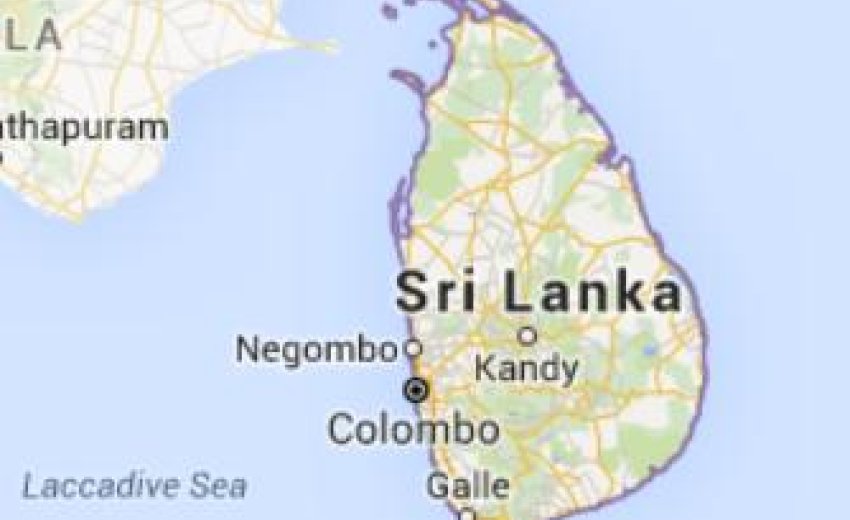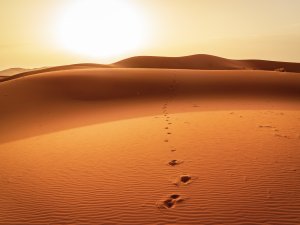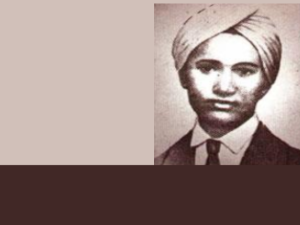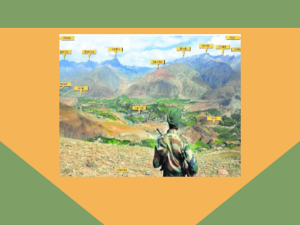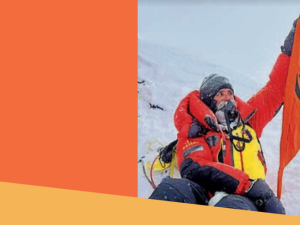Footprints of GURU NANAK's TRAVELS in SRI LANKA
PART I
BACKGROUND
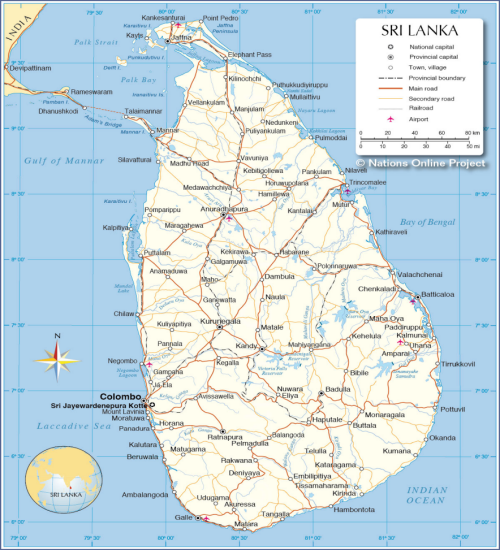 Writer of this article has been doing research on Guru Nanak's travels for last 40 years. After collecting all available information he recently (April 2016) visited Sri Lanka to research the footsteps of Guru Nanak in various locations in Sri Lanka. He studied all available material before proceeding and photographed/videographed the available evidence, visited libraries and museums all over in Sri Lanka and held discussions with persons who mattered. The following account of Guru Nanak's visit to Sri Lanka is the result of these efforts.
Writer of this article has been doing research on Guru Nanak's travels for last 40 years. After collecting all available information he recently (April 2016) visited Sri Lanka to research the footsteps of Guru Nanak in various locations in Sri Lanka. He studied all available material before proceeding and photographed/videographed the available evidence, visited libraries and museums all over in Sri Lanka and held discussions with persons who mattered. The following account of Guru Nanak's visit to Sri Lanka is the result of these efforts.
The pear shaped island of Sri Lanka or Sinhaladwip of Kautilya's Arthasastra appears like a hanging beehive. Situated between Northing 50 55' minutes to 90 50' and Easting 790 85' minutes to 810 85' minutes, it is spread 432 Kilometers North to South in an area of 65,630 Sq. kilometers. Mainland Sri Lanka is either sea coast or mountain ranges averaging 2530 meters in height running north to south. The north is plainer than the south. Average temperature remains at 12 degrees and rains are heavy, i.e., up to 200 inches, Most of the area is full of greenery, either of tea gardens, coconut trees or hilly-bushes. Only 1/5th is under cultivation. [1] India's Rameshwaram where, according to Ramayana, Lord Rama constructed a bridge, known as Adam's Bridge, is closest to Sri Lanka: only half an hour by boat. The shallow watery ridge of 40 kilometers confirms that it was separated from the Indian subcontinent in recent geological times- c. 7000BP.[2] This proximity has been the cause of deep influences of India on history and culture of Sri Lanka. The two main religions of the island i.e., Buddhism and Hinduism and other two religions Islam and Christianity are an import from India.
According to a mythical legend Sri Lanka was formed when sage Narada persuaded the God of Wind and Air, Vayu, to humble his close friend, Mount Meru. Vayu then spent the next year blowing strong winds at the mountain, which was shielded by Garuda, a mythical bird. When Garuda took respite for a while, Vayu caused part of the apex of the mountain to fall into the sea, forming the island of Sri Lanka.
According to the Hindu epic Ramayana Sri Lanka was ruled by Yaksha king Kubera by his half-brother Ravana usurped the kingdom from him The Ramayana mentions of Rama's Bridge (also called Adam's bridge) constructed with rocks by Rama with the help of Hanuman and others. Many believers view the sand bar islands connecting Sri Lanka to India as the remains of the bridge are seen in satellite images. Archeological evidence is also found to support worship of Lord Shiva in parts of Sri Lanka, from pre-historic times, prior to the arrival of Prince Vijaya. Even Ravana was a devout follower of Lord Siva.[3] India and Sri Lanka have planned to link each other by a new bridge now.
The 5th century Pali chronicle, the Mahavamsa, refers to Brahmin Purohitas or palace advisers in the courts of the early Sinhalese kings before the advent and after the introduction of Buddhism. The Mahavamsa notes a Tamil presence in the island at an early stage be they immigrant from South India, mercenaries, traders or court officials. The earliest Hindus were the indigenous Heala people who were traditional worshippers of Lord Shiva and followers of Saiva Sidhantam, the oldest existing Hindu school of thought. Evidence states the earliest inhabitants of the island were the Nagas and Yakshas. The Naga inhabited Nagadipa were probably the ancestors of the indigenous Heala people. The Nagas practiced an early form of Hinduism that worshipped Lord Shiva and serpents. This form of animistic Shaivism is common in parts of Tamil Nadu and India.[4]
Hinduism was probably the dominant religion in Sri Lanka before the arrival of Buddhism in the 3rd century BC. Buddhism was introduced into Sri Lanka by Mahinda, the son of the Emperor Ashoka, during the reign of King Devanampiya Tissa.[5] However it was activity from across the Palk Strait that truly set the scene for Hinduism's survival in Sri Lanka. Shaivism (devotional worship of Lord Shiva) was the dominant branch practiced by the Tamil peoples thus most of the traditional Hindu temple architecture and philosophy of Sri Lanka drew heavily from this particular strand of Hinduism. Thirugnanasambanthar mentioned the names of a number of Sri Lankan Hindu temples in his works.[6]
The elite and the upper classes, consisting of the higher castes, amongst the Tamils adhere to what is known as the Shaiva Sidhanta or Dvaita school of Shaivism as against Vedanta in India. Dvaita school of Shaivism differentiates between the soul, God and actions or Karma as opposed to the unity of the soul and God as expounded by the Vedanta school. Most other Sri Lankan Hindus follow what is commonly known as folk Hinduism without the baggage where they usually worship a village, clan or tribal deity within or outside the accepted pantheon of Hindu deities like Kannaki, Mariamman, Draupdi, Ayyanar and Vairavar.
Religion is a compulsory subject in Sri Lankan schools. Hindu students can choose from either Hinduism or Saiva Siddhanta as a compulsory subject from Grade 1 to Grade 11. Sri Lankan Tamils mostly study Saiva Siddhanta while upcountry Tamils mostly study Hinduism.
According to the 1981 census, there were 2,297,800 Hindus in Sri Lanka. The 2012 census reported 2,554,606 Hindus in all of Sri Lanka. Hindus constitute the overwhelming majority of Tamils in Sri Lanka. Highest proportion of Hindus is found in Eastern Sri Lanka (Close to 91% of all Tamils, with 92% in Amparai and Batticaloa and 87% in Trincomallee). In the Central Province also the proportion of Hindus is more than 90% of the Tamil population. (91% each in Matale and Nuwara Eliya and 88% in Kandy). In Northern Province 84% of all Tamils were Hindus (90% in Vavuniya, 87% in Jaffna and Mullaitivu and 42% in Mannar).[7][8][9]
Megasthanese visited India in 3rd-4th century and mentioned that the settlers in Ganges Valley were conversant with the name and location of Sinhala Dweep.[10] The oldest recorded history of Sri Lanka is available in Mahavansh. According to this book, Sri Lanka was first occupied by a group of people from Bang (Bengal) and Vijaya was the fist king. Sinhala Dweep was the name given by these early settlers. There had been frequent fights between the various chieftains who ruled various parts of Sri Lanka. Aid was frequently received from Southern Indian kings. Later Pandya, Chola and Vijaynagar kings tried to expand their rule to Sri Lanka and attacked it many a time.[11]
Janam Sakhis[12] have recorded Guru Nanak's visit to Singhladwip. In the first decade of sixteenth century, when Guru Nanak visited this country, the rulers were from Prakarmbahu dynasty. Shivnabh or Sheonabh (Walait Wali Janam Sakhi p.46-8, Janamsakhi Bhai Bala p.258-9, Janamsakhi Bhai Mani Singh p.354-6 Bhai Bahilo's 'Soochak Parsang Guru Ka' and Haqiqat Rah Muqeem) and as Shivnathin in Janamsakhi Meharban (p.162-4) was the king when Guru Nanak visited Sri Lanka.
Janamsakhi Walaitwali mentions that Guru Nanak, 'covered his head with ropes, and tied ropes around arms and legs during his visit to the South. He wore wooden sandals in his feet and had a vermilion mark on his forehead. He was accompanied by Saido and Seeho Gheho, Jat by caste.' In Janamsakhi Bhai Bala the duration of the visit to Sri Lanka is found recorded as follows: "Further they reached the kingdom of King Sheonabh Sangla Deep in one and a half month----Guru Nanak stayed there for two years five months." (p.258-9). This period however needs further scrutiny. His method of travel is described in Janamsakhi Meharban: "If Baba so felt, he walked for days together or sat for many days. For many days he remained meditating and for many days he remained quiet." (p. 131). His Sri Lanka travel was by boat/ship from one port to another and on foot when going cross-country.
The purpose of Guru Nanak's visit to Sri Lanka was to spread the message of Universal God and the Ultimate Truth. A follower of Guru Nanak, Mansukh, Bania (trader) by caste of Lahore, had visited Sri Lanka earlier on many business trips. Mansukh was a keen devotee of Guru Nanak. He recited Guru's hymns and lived a pious life. King Shivnabh was very much impressed by trader's devotion to the Guru. He became eager to pay his obeisance to Guru Nanak. On the request of this trader, Guru Nanak visited Sri Lanka.
According to a legend recorded in chronicles, 300 years before King Bikramditya ruled in India King of Kashi Ranjit Singh went for a pilgrimage of Rameshwararm. He had nine sons. He handed over Kashi to his elder son before moving taking along with eight remaining. Meanwhile the King of Madurai died without any offspring. There was a struggle for the kingdom among the ministers. Some ministers met Ranjit Singh and requested him to take over the kingdom, which the King did without delay. As he got established, he thought of increasing his kingdom and leaving his one son he attacked Sri Lanka with his seven sons. His army included men from Kashi as well as from Bhils of Madurai. After capture of Sri Lanka he divided it among his seven sons. He stayed in the middle kingdom with his one son since it was a healthy area. With the presence of the father, the control of the entire kingdom remained with the father through the son present with him. All the courtiers and soldier from Kashi and Bheels from Madurai got settled in Sri Lanka.
King Ranjit Singh was a great devotee of Shiva since one of the important 12 Sivhivling temples in Kashi and he himself came to Rameshwaram to visit the temple containing Shivling at that place. All Bheels were the followers of Kartikeya. These two groups started worshipping Shiv and Kartikeya. There was no conflict since Kartikeya was the son of Shiva and was the Commander of Devas. Thus large number of temples was constructed for worshipping Shiv and Kartikeya. After Emperor Ashok sent his son and daughter with the bo-tree to Sri Lanka, Buddha religion started gaining ground. However even Buddhism accepted Kartikeya as their deity. The followers believed that Kartikeya has married to two Bhil girls 'Diwani Amma' and 'Wali Amma' to emancipate the lowliest of the low hence must be worshipped for the same. This way in addition to Shiva and Kartikeya temples were erected for 'Diwani amma' and 'Wali Amma' as well, Kartikeya worship remaining supreme. Since King Ranjit Singh came from Kashi on Ganges, he named the largest rivers as 'Ganga'.
The son, who controlled all these kingdoms from Kandy area, was succeeded by Shivnabh in later generations. Shivnabh's seventh generation was King Dharamnabh from whom the British took over control of Sri Lanka.
According to another legend, the king used to observe fast on Ikadashi (first of each lunar month) and enforced this on his people. Those who did not do so were punished. The trader did not observe fast as he used to sing hymns of the Lord and distribute prasad on lkadashi. The king got him arrested on a complaint and enquired as to why he did not observe the fast. The trader stated that it was his Guru's teachings that those who eat less and worship the Lord, they observe lkadashi daily. The king enquired, "Who is your Guru?" The trader said, "My Guru is Nanak of Kartarpur.'' The king then said, "I wish to see Guru Nanak. How can I see him?" The trader said, "You pray to the Lord, construct Guru's place and serve the visiting saints. Guru Nanak will be seen by you as well." The king enquired further, "Which form does he appear?" The trader said, "He will appear as a saint. You have to keep faith and remember him." The king made Guru's place in a dried up garden and started serving the visiting saints." When in Punjab, Mansukh narrated Shivnabh's eagerness to meet Guru Nanak. "Listen to this", Guru Nanak told his companion Mardana: "It is important that we go there." Mardana agreed with the Guru and they left towards South.
Dr. Saddamangala Karunratna, M.A. (Ceylon), Ph.D. (Cantab.) Assistant Commissioner of Archeology, Ceylon in his paper, "Guru Nanak and Ceylon"[12] at the International Seminar on the Life and Teachings of Guru Nanak at the Punjabi University, Patiala held from September 3-5, 1969 referred of an original writing on a slab numbered M-111 preserved in the Archeological Museum at Anuradhapura which mentions of Nanakacharya's visit to Sri Lanka. It contains a passage in Sanskrit scribbled in very small characters which is said to have been written by the orders of the king Dharama Prakrambahu IX, who ascended the throne in 1493 A.D. The paper mentions that in the fifteenth year of reign of Dharama Parkarambahu IX, Jnanakacarya, a divine from abroad is said to have visited Jayavardhana. He propagated a New Faith. He met the ruler and explained to him the tenets of his Faith. The king is said to have promised to embrace the New Faith, if the saint defeated his Sangharaja, Dharamakriti-sthavira by name.
A public meeting was arranged in front of the palace, where a debate on Ishvara and Soul was held between Jnankacarya and Dharamakriti-sthavira. The saint defeated the Sangharaja. The powerful Brahmans of the court, who did not like the Sangharaja were happy over the outcome of the debate. They wanted to see him disgraced. According to the custom, the result depended on the majority of votes of audience. It is said that the Brahmins had also arranged a majority for Jnanankacarya.
After the defeat of Dharamakriti-sthavira, Jnanankacarya approached the king and asked him to keep his promise. But the king said that he would be able to give reply after making enquiries about the result of the debate.
When the Brahmins ascertained that the faith of Jnanakacarya laid emphasis on monotheism and rejected idol-worship and caste-system, they could not relish the idea of the embracement of this New Faith by the king, because it would definitely end their supremacy in the court. Therefore they acquired the support of a monk named Dharamadhvaja-Pandita, a scholar of Sanskrit, Pali, Hinduism and Buddhism. This scholar challenged Jnanakacarya for a debate, which was accepted. A public debate was again arranged in front of the palace. But the Brahmans had managed a majority beforehand. The subject of the debate was image-worship. At the end of the debate the voting took place and the result was manipulated for a win of Dharamadhvaja-Pandita as expected Then Jnanakacarya left Jayavardhanpura. This way the Brahmins first got rid of Dharamakriti-sthavira and then managed to strengthen their position in the court by forcing Jnanakacarya to leave the capital and save the king from following the new faith. Dr Karunaratna feels that the word Jnanakcarya has been used for Guru Nanak.'[12]
Janamsakhi Prampra[13] edited by Dr Kirpal Singh has a mention of Guru Nanak to Sri Lanka (Singhladeep) in all the compiled Janamsakhis though these Janamsakhis specify the visit only to King Shiv Nabh and no other place. 'Then Guru Nanak thought of visiting Singhladeep' ('Tab Singhladeep ki surt(i) hoee') (Janamsakhi Walait Wali mentions on visit to King Shivnabh, p. 46-47), 'Then Guru Nanak came to the palace of King Shivnabh' ('Tab Guru Baba ji Raje Shivnabh kai graeh mah(i) aae.') (Janamsakhi Meharban Vol. 2, Pothi Har(i)ji, p.162-164), 'Next they moved to King Shivnabh's city in Sangladeep in one and a half month" ('Agge Sanghladeep de sahar(u) Raje Shionabh di nagri dedh mahine vich gaye') (Janamsakhi Bhai Bala, pp. 258-259) 'Babaji (Guru nanak) landed in the garden of King Shivnabh' ('….Baba ji Shivnabh Raje de bag jai utre.') (Janamsakhi, Bhai Mani Singh, pp. 354-356). Even Bhai Paira in 'Haqeeqat Rah Muqeem' mentions of Guru Nanak's visit to King Shiv Nabh, though it mentions King Shiv Nabh to be the grandfather of King Mayadunne who ruled from Sitwaka (1521-1581AD).[14] Later Bhai Behlo[15] (-died 24 March 1604AD) also mentions of Raja Shivnabh, Raja Shivnabh find the complete one in him (Guru Nanak) ('Raje Shivnabh pooran paya'). Ratan Singh Bhangu[16] mentions: Shivnabh was stated to be the king. There Guru Nanak made his Sikhs… After Singhladeep he visited many other countries. ("Sivnabh des kou raja kahe. Tih ja satgur sikh banvae….Sanghal deep langh aur kete.") From Charanpad, the place maintained by an Udasi caretaker (at Adam's Peak) Guruji returned to Sultanpur after visiting Singhladeep and Mecca. ('Charanpadka, Udasi…eehan se chal Singhladeep ar Makke ki yatra kar Guru ji fir Sultanpur ae.') Sri Guru Teerath Sangreh.[17]
Dr Surinder Singh Kohli, (1969) in Travels of Guru Nanak[18] mentions Trincomalee, Batticaloa, Dibar, Kurukalmadam, Kandy, Nuwara Eliya, Adm's Peak, Pussalawa (Pushalpur), Ramboda, Badulla, Kotte (Colombo), Mardana Junction, Anuradhapura, Jaffapatnam, Bagharey in Naiynativu island and Manar as the places visited by the Guru in Sri Lanka. In Jeevan Charit Guru Nanak Dev Dr Trilochan Singh (1972)[19] mentions of Guru Nanak's boarding a ship from Rameshwaram to Jappaptnam (Jaffna) to King Shivnabh, Seetwaka, Kurukalmadam, Pushkardeep and Ashok Van.
Though no two accounts are the same, from these sources the common places visited by Guru Nanak turn out to be Jappapatnam (Jaffapatnam), Bagharey in Naiynativu island Trincomalee, Batticaloa, Dibar, Kurukalmadam, Kalmunae, Tiukoil, Patuvil, Panam, Katargama (Kartik Swami temple), Badulla, Nuwara Eliya, Kandy, Adm's Peak, Sitwaka (Aviswella) Pussalawa (Pushalpur), Ramboda, Kotte (Colombo), Mardana Junction, Anuradhapura, and Manar. The period the visit is agreed to be between 1911-1912 AD.[18][19]
The places of Guru Nanak's visit mentioned by the above researchers thus turn out to be Nagapatnam (India) to Sri Lanka's Jaffna, Nayinativu Trincomalee, Batticaloa, Dibar, Kurukalmadam, Kalmunae, Tiukoil, Patuvil, Panam, Katargama ( Swami Kartik Swami temple) near Khandi city on the bank of Manak Ganga, Badulla, Nuwara Eliya, Ashok Vani, Pushpalpur (Pushala) on the bank of Champa river, Bijaygarh, Lankagarh, Nagalpatti, Meghdambar Parbat, Sitwaka (Aviswella) Kotte (Colombo), Anuradhapura, Manar and Rameshwaram (India).
Guru Nanak's travels to Sri Lanka are thus confirmed by Janamsakhis, Haqiqat Rah Muqeem, the inscription number 111 in Anuradhapura Archeological Museum and the chronicles but the exact time and locations visited needs further confirmation. This is attempted in succeeding parts of this paper.
References-I
1. Francis W, 2002, Gazetteer of South India, Vol. I, Mittal Publications, p.161
2. Deraniyagala, The Pre-history of Sri Lanka, Vol.1, p.167.
3. Namita Gokhale, 2009,The Book of Shiva, Penguin Books India, p. 104.
4. https://en.wikipedia.org/wiki/List_of_Sinhalese_monarchs
5. Francis W, 2002, Gazetteer of South India, Vol. I, Mittal Publications, p.161
6. Lecture on Hindu sculpture and architecture of Sri Lanka Sunday Times - September 29, 2010.
7. Rasanayagam, C., 1926, Ancient Jaffna, Asian Educational Services (1993 reprint), p.1.
8. Manokaran C., The Untold Story of Ancient Tamils in Sri Lanka (PDF), Retrieved 21 July 2013.
9. Peter Schalk. Serendipity - Issue 02 - The Vallipuram Buddha Image - Again, Rootsweb.ancestry.com. Retrieved 2013-11-12.
10. Francis W, 2002, Gazetteer of South India, Vol. I, Mittal Publications, p.161
11. https://en.wikipedia.org/wiki/List_of_Sinhalese_monarchs
12. Reproduced from Dr Surinder Singh Kohli’s Travels of Guru Nanak, pp. 201-202.
13. Kirpal Singh Dr., (ed), December 1989, Janamsakhi Parampara, Punjabi University, Patiala.
14. Ganda Singh Dr(ed), The Punjab Past and Present, Vol III, 1969, Punjabi University, Patiala, Punjabi p. .12.
15. Op Cit p.270.
16. Op Cit, pp.52-53
17. Tara Singh Narotam, 1884, Temple Press Ambala, Samwat, p.10 entry 13.
18. Surinder Singh Kohli, Dr.,1969, Travels of Guru Nanak, Punjab University, Amritsar, 2nd edn 1978.
19. Trilochan Singh Dr 1972, Jeevan Charit Guru Nanak Dev, Dilli Sikh Gurdwara Board, Delhi, pp.201-227
